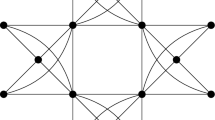Abstract
In this paper, we consider the capacity limits of the cellular network by modeling it as consisting of two mutually interfering multiple access channels with multiple antennas at each receiver (e.g., base station). By developing a tight outerbound as well as an achievable scheme which exploits the idea of interference alignment, we are able to exactly characterize the sum degrees of freedom (DoF) of the network when the channel coefficients are time- or frequency-varying, which equals \( \frac{{KM}} {{K + \min (M,K)}} \) (where M and K denote the number of receiver antennas and number of users in per cell, respectively) per cell. From the DoF result, it can be observed that in addition to the multi-user gain which has been reported for the network with single-antenna BSs, there also exists the multi-antenna gain in the cellular network. In particular, when the number of users is large, we can nearly achieve the interference-free DoF of a cellular network with multiple-antenna BSs, which is a somewhat surprising result.
Similar content being viewed by others
References
Han T S, Kobayashi K. A new achievable rate region for the interference channel. IEEE Trans Inf Theory, 1981, 27: 49–60
El-Gamal A, Costa M H. The capacity region of a class of deterministic interference channels. IEEE Trans Inf Theory, 1982, 28: 343–346
Etkin R, Tse D, Wang H. Gaussian interference channel capacity to within one bit. IEEE Trans Inf Theory, 2008, 54: 5534–5562
Kramer G. Outer bounds on the capacity of Gaussian interference channels. IEEE Trans Inf Theory, 2004, 50: 581–586
Maddah-Ali M, Motahari A, Khandani A. Signaling over MIMO multi-base systems-combination of multi-access and broadcast schemes. In: Proc of IEEE ISIT, Seattle, USA, 2006. 2104–2108
Jafar S A, Shamai S. Degree of freedom region for the MIMO X channel. IEEE Trans Inf Theory, 2005, 54: 151–170
Høst-Madsen A, Nosratinia A. The multiplexing gain of wireless networks. In: Proc. IEEE Int. Symp. Inf. Theory, Adelaide, Australia, 2005
Jafar S, Fakhereddin M. Degrees of freedom for the MIMO interference channel. IEEE Trans Inf Theory, 2007, 53: 2637–2642
Cadambe V R, Jafar S A. Interference alignment and degrees of freedom of the K-user interference channel. IEEE Trans Inf Theory, 2008, 54: 3425–3441
Cadambe V R, Jafar S A. Degrees of freedom of wireless X networks. 2007. arxiv:cs/0711.2824
Suh C, Tse D. Interference alignment for cellular networks. In: Proc. of 46th Annual Conference on Communication, Control and Computing, 2008. 1037–1044
Gomadam K S, Cadambe V R, Jafar S A. Approaching the capacity of wireless networks through distributed interference alignment. 2008. arXiv: 0803.3816
Gou T, Jafar S A. Degrees of Freedom of the K user M × N MIMO interference channel. arxiv:cs/0809.0099v1
Shang X, Kramer G, Chen B. A new outer bound and the noisy interference sum-rate capacity for Gaussian interference channels. IEEE Trans Inf Theory, 2009, 55: 689–699
Motahari A, Khandani A. Capacity bounds for the Gaussian interference channel. IEEE Trans Inf Theory, 2009, 55: 620–643
Annapureddy V, Veeravalli V. Gaussian interference networks: sum capacity in the low interference regime and new outer bounds on the capacity region. Submitted to IEEE Trans Inf Theory, 2008. arxiv:0802.3495
Sun J, Liu Y, Zhu G. On degrees of freedom of the cellular network in the general setting. To be submitted to IEEE Trans Inf Theory
Author information
Authors and Affiliations
Corresponding author
Rights and permissions
About this article
Cite this article
Sun, J., Liu, Y. & Zhu, G. On degrees of freedom of the cellular network. Sci. China Inf. Sci. 53, 1034–1043 (2010). https://doi.org/10.1007/s11432-010-0085-x
Received:
Accepted:
Published:
Issue Date:
DOI: https://doi.org/10.1007/s11432-010-0085-x



